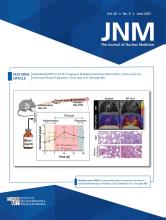A 76-y-old man presented with a history of difficulty with urination, frequent awakening at night due to nocturia, and an elevated level of prostate-specific antigen (27.4 ng/mL). The past medical history included chronic obstructive pulmonary disease with prior emergency room visits due to exacerbation. Prostate MRI discovered a very high-risk 2.3-cm prostate lesion invading the seminal vesicles and prostate capsule, with suggestive left external and internal iliac lymph nodes. Prostate biopsy showed prostate adenocarcinoma with a Gleason score of 4 + 3 = 7. To complete the staging, a prostate-specific membrane antigen (PSMA) PET/CT examination was performed using 370 MBq (10 mCi) of 18F-piflufolastat, which demonstrated intense activity within the prostate lesion, many lymph nodes (bilateral iliac, bilateral paraaortic, and right retrocrural), and diffuse bronchial uptake (Fig. 1).
18F-piflufolastat PSMA PET/CT highlighting increased uptake throughout large airways.
18F-piflufolastat was approved by the Food and Drug Administration on May 27, 2021, to identify prostate cancer metastasis or recurrence. Although PSMA usually localizes to prostate cancer, this antigen is expressed on a variety of cells. Afshar-Oromieh et al. showed 68Ga-PSMA-11 uptake in benign inflamed lymph nodes, with high PSMA expression in nodes undergoing follicular hyperplasia (1). Gordon et al. found high PSMA expression in neovascularization and inflammatory cell using formalin-fixed tissues (2).
68Ga-PSMA-11 has been reported to localize in small peripheral airways in the setting of bronchiectasis, with follow-up bronchoscopy and lavage demonstrating inflammatory cells (3). However, to the best of our knowledge, ours is the first clinical report of large-airway PSMA localization. The patient had poorly controlled chronic obstructive pulmonary disease, with likely chronic inflammation of the airways resulting in PSMA localization, a potential false-positive finding that is important to highlight.
DISCLOSURE
No potential conflict of interest relevant to this article was reported.
Footnotes
Published online Jan. 5, 2023.
- © 2023 by the Society of Nuclear Medicine and Molecular Imaging.
- Received for publication November 29, 2022.
- Revision received December 21, 2022.








